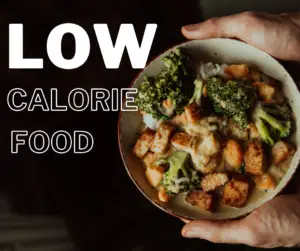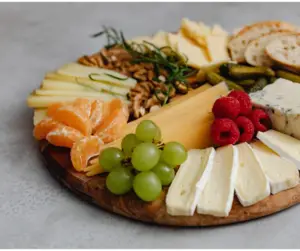
In a world where watching calories is a prevalent trend, discovering truly satisfying low-calorie foods can feel like an uphill task. Many assume such options to be bland, leaving us hungry soon after. Yet, finding flavorful, filling, and low-calorie foods isn’t an impossible feat. There’s a rich array of low-calorie options surprising in their ability to stave off hunger while pleasing your taste buds.
This article dives into the realm of low-calorie foods that exceed expectations in satisfying hunger. We’ll explore the science behind feeling full and the elements contributing to satiety. Moreover, we’ll introduce a curated selection of low-calorie foods that not only tantalize your taste buds but also keep those hunger pangs in check.
The Science Behind Feeling Full

Understanding the science behind feeling full, known as satiety, is crucial when choosing low-calorie foods that genuinely satisfy your appetite. Several factors contribute to how filling a specific food can be:
Fiber Content:
Dietary fiber plays a pivotal role in promoting satiety. This indigestible carbohydrate stays in the digestive system longer, creating a sense of fullness. High-fiber foods like vegetables, fruits, whole grains, and legumes take longer to digest, aiding in keeping you satisfied for extended periods.
Protein Content:
Protein is another key macronutrient that significantly influences satiety. Consumption of protein-rich foods triggers the release of hormones signaling fullness to the brain. Additionally, protein aids in preserving muscle mass, crucial for overall health. Lean options such as chicken breast, turkey, and fish are ideal for feeling full on fewer calories.
Water Content:
Foods high in water content, such as fruits and vegetables, can fill you up without adding many calories. These water-rich foods have low energy density, providing fewer calories per gram. The added hydration can also help curb your appetite.
Nutrient Density:
Nutrient-dense foods contain essential vitamins, minerals, and beneficial compounds in every calorie. Consuming nutrient-dense foods supplies your body with necessary nutrients, potentially reducing feelings of hunger. Choices like leafy greens, berries, and nuts are excellent examples of nutrient-dense options.
high volume low calorie foods

Discovering low-calorie foods that genuinely satisfy your appetite offers a vast selection of nutritious, delicious, and versatile options. These foods not only nourish but also excel in various culinary creations. Here are some top-performing low-calorie foods that keep you feeling full and content:
Leafy Greens:
Kale: A nutritional powerhouse with minimal calories, packed with vitamins, minerals, and antioxidants. Use it in salads, smoothies, or bake it into crispy chips.
Spinach: Low in calories and high in nutrients, it’s a versatile addition to omelettes, sandwiches, and pasta dishes.
Swiss Chard: Known for its vibrant colors and earthy taste, it’s rich in vitamins A and K. Try sautéing it with garlic and olive oil for a flavorful side dish.
Lean Proteins:
Chicken Breast: A lean protein source, versatile for grilling, baking, or sautéing various dishes.
Fish: Cod and salmon, low in calories and high in heart-healthy omega-3 fatty acids, perfect when broiled or grilled with herbs and spices.
Legumes:
Lentils: Protein and fiber-rich, ideal for hearty soups and stews.
Chickpeas: Versatile for snacking, making hummus, or adding to salads for extra protein.
Black Beans: A protein and fiber source, great for Latin American dishes like burritos and salads.
Whole Grains:
Quinoa: A complete protein and fiber source, perfect for grain bowls or side dishes.
Oats: High in complex carbohydrates and soluble fiber, excellent for a satisfying breakfast with berries and nuts.
Barley: Rich in fiber and nutty in flavor, a hearty addition to soups, stews, or salads.
Fruits:
Apples: Low in calories with natural sweetness and fiber, an easy, healthy snack.
Berries: Low in calories and rich in antioxidants, great additions to yogurt, oatmeal, or enjoyed alone.
Oranges: Citrusy and hydrating, their high water content helps keep you satisfied.
HOW TO ADD Low-Calorie, Filling Foods in to you deit

Having explored the top low-calorie foods that are remarkably filling, let’s delve into inventive methods to incorporate these ingredients into your meals and snacks. These ideas not only promote fullness but also infuse variety and taste into your diet:
Salad Creations:
Mediterranean Quinoa and Chickpea Salad: Mix cooked quinoa, chickpeas, cherry tomatoes, cucumbers, red onions, and fresh herbs like parsley and mint. Dress it with a lemon vinaigrette for a satisfying and vibrant salad.
Grilled Chicken and Spinach Salad: Thinly slice grilled chicken breast and toss it with fresh spinach, cherry tomatoes, sliced almonds, and a light balsamic vinaigrette for a protein-rich salad.
Smoothie Innovations:
Berry Protein Smoothie with Greek Yogurt: Blend mixed berries, Greek yogurt, a scoop of protein powder, and a touch of honey for a creamy and protein-packed breakfast or snack.
Kale and Pineapple Green Smoothie: Mix kale leaves, pineapple chunks, banana, and coconut water for a nutrient-dense green smoothie that’s refreshing and fulfilling.
Snack Varieties:
Apple Slices with Almond Butter: Dip apple slices in almond butter for a balanced and fiber-protein combo snack.
Spiced Roasted Chickpeas: Toss canned chickpeas with olive oil, paprika, cumin, and roast them for a crispy, protein-rich snack.
Meal Preparation Insights:
Batch-Cook Lean Proteins: Grill chicken or turkey breast in advance for use in salads, wraps, and other recipes throughout the week.
Preparing Pre-cut Fruits and Veggies: Wash and cut fruits like carrots, celery, and bell peppers, storing them in portion-sized containers for quick, convenient snacks on-the-go.
simply filling foods list
| Vegetables | Fruits | Proteins |
|---|---|---|
| Leafy greens | Apples | Skinless chicken breast |
| Bell peppers | Berries | Turkey breast |
| Broccoli | Oranges | Lean cuts of beef and pork |
| Carrots | Bananas | Fish (salmon, cod, tuna) |
| Cauliflower | Grapefruits | Eggs |
| Cabbage | Peaches | Tofu |
| Tomatoes | Pears | Beans (black beans, kidney beans) |
| Cucumbers | Melons (watermelon, cantaloupe) | |
| Onions | ||
| Zucchini |
| Whole Grains | Dairy and Dairy Alternatives | Healthy Fats |
|---|---|---|
| Brown rice | Fat-free or low-fat plain Greek yogurt | Avocado |
| Quinoa | Skim milk | Nuts and seeds (in moderation) |
| Oats | Non-fat cottage cheese | |
| Barley | Unsweetened almond or soy milk | |
| Whole grain bread |
| Extras |
|---|
| Herbs and spices |
| Vinegar |
| Broth or stock (low-sodium) |
| Natural sweeteners (like stevia) |
Conclusion
Unleash your culinary creativity with salads, smoothies, and snacks featuring these wholesome foods. Remember, managing portion sizes is key—adopt mindful eating practices and opt for smaller plates to keep calories in check.
Embrace the understanding that this journey towards a healthier lifestyle isn’t about flawless precision but rather continual advancement. Experiment with these ingredients, discover what resonates with your taste buds and lifestyle, and delight in crafting nourishing meals that fuel your well-being on this enriching path to health!
Frequently Asked Questions
What foods fill you up but are low in calories?
Foods high in fiber and water content, like vegetables (e.g., broccoli, spinach), fruits (berries, apples), and lean proteins (chicken breast, fish), can help you feel full with fewer calories.
What foods are lowest in calories?
Non-starchy vegetables such as cucumbers, celery, lettuce, and leafy greens generally have very low calorie counts per serving.
Which food is best for weight loss?
A balanced diet including lean proteins, fruits, vegetables, whole grains, and healthy fats supports sustainable weight loss.
How can I eat 1200 calories a day without being hungry?
Focus on nutrient-dense foods like vegetables, lean proteins, and whole grains. Spread meals throughout the day and include sources of healthy fats and fiber to help control hunger.
What to eat to lose belly fat?
Foods high in fiber, protein, and healthy fats, such as avocados, nuts, seeds, whole grains, and lean proteins, can support belly fat loss when part of a balanced diet.
What is the healthiest breakfast to lose weight?
Options like oatmeal with fruit and nuts, Greek yogurt with berries, or whole-grain toast with avocado and eggs provide a balance of nutrients to start the day.

